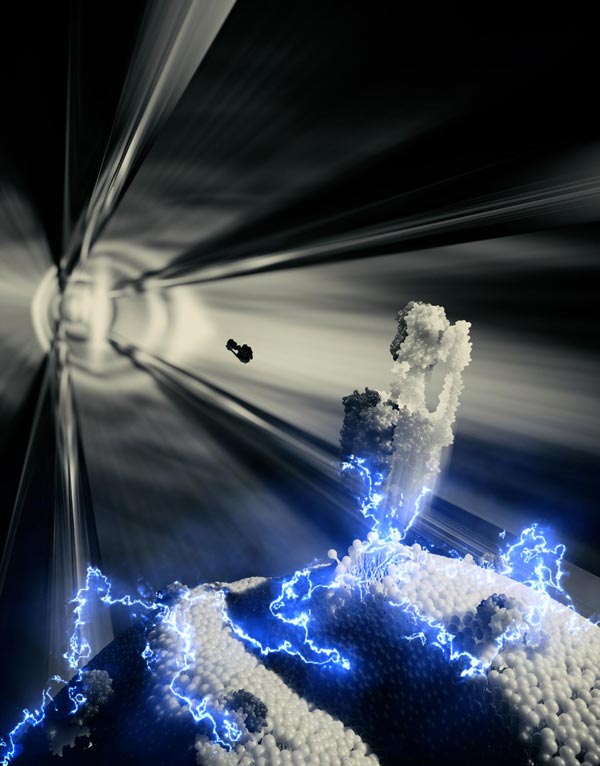New way to look at cell membranes could change the way we study disease

A new technique to analyse cell membrane proteins in situ which could revolutionise the way in which we study diseases, such as cancer, metabolic and heart diseases. Image credit: OU
The discovery was made as part of an international research collaboration, led by Oxford University, alongside peers including Imperial College London. The technique could dramatically affect our understanding of both how cell membrane complexes work, and in the process, our approach to healthcare research.
Membranes protect all of our cells and the organelles inside them, including the mitochondria – the powerhouse of the cell. These membranes are studded with biological machinery made of proteins that enable molecular cargo to pass in and out.
This research, published in Science, will enable the development of mass spectrometry (a tool used to analyse the make-up of matter) in biology to be taken to a new level, enabling new discoveries that would not have been possible before.
Studying these membrane-embedded machines in their native state is crucial to understanding mechanisms of disease and providing new goals for treatments. However, current methods for studying them involve removing them from the membrane, which can alter their structure and functional properties.
Lead researcher Professor Dame Carol Robinson, Professor of Physical Chemistry at Oxford's Department of Chemistry, said: 'For decades, scientists have had to extract these proteins from their membranes for their studies. But imagine what you might discover if you could get proteins straight from the membrane into a mass spectrometer?
'I wasn't sure this would ever work; I thought the membrane environment would be just too complicated and we wouldn't be able to understand the results. I am delighted that it has because it has given us a whole new view of an important class of drug targets.'
The technique involves vibrating the sample at ultrasonic frequencies so that the cell begins to fall apart. Electrical currents then applied an electric field to eject the protein machines out of the membrane and directly into a mass spectrometer – an instrument that can detect a molecule's chemical 'signature', based on its mass.
Not only did the membrane protein machines survive the ejection; the analysis also revealed how they communicate with each other, are guided to their final location and transport their molecular cargo into the cell.
Professor Steve Matthews, from the Department of Life Sciences at Imperial, said: 'With the development of this method, the application of mass spectrometry in biology will be taken to a new level, using it to make discoveries that would not have been possible before.'
Dr Sarah Rouse, also from the Department of Life Sciences at Imperial, said: 'A longstanding question on the structure of one membrane machine from mitochondria has now been solved using this technique. Mitochondria are particularly interesting because there are several diseases that target them specifically, that we may now be able to design new therapies for.'
Of the study's potential impact Professor Dame Robinson added: “The results are particularly exciting for mitochondrial membranes–we managed to catch a translocator in action–passing metabolites. Because mitochondrial therapeutics target a wide range of debilitating diseases, we now have a new way of assessing their effects.'
###
Notes to editors
The full paper citation is:
Protein assemblies ejected directly from native membranes yield complexes for mass spectrometry Dror S. Chorev1 , Lindsay A. Baker2 , Di Wu1 , Victoria Beilsten-Edmands1 , Sarah L. Rouse3 , Tzviya Zeev-Ben-Mordehai2 *, Chimari Jiko4 , Firdaus Samsudin5 , Christoph Gerle6,7, Syma Khalid5 , Alastair G. Stewart8,9, Stephen J. Matthews3 , Kay Grünewald2,10, Carol V. Robinson1 †
Link to the paper:
http://science.
For further information please contact Lanisha Butterfield, Media Relations Manager on 01865 280531 or email lanisha.butterfield@admin.ox.ac.uk
Media Contact
All latest news from the category: Life Sciences and Chemistry
Articles and reports from the Life Sciences and chemistry area deal with applied and basic research into modern biology, chemistry and human medicine.
Valuable information can be found on a range of life sciences fields including bacteriology, biochemistry, bionics, bioinformatics, biophysics, biotechnology, genetics, geobotany, human biology, marine biology, microbiology, molecular biology, cellular biology, zoology, bioinorganic chemistry, microchemistry and environmental chemistry.
Newest articles

First-of-its-kind study uses remote sensing to monitor plastic debris in rivers and lakes
Remote sensing creates a cost-effective solution to monitoring plastic pollution. A first-of-its-kind study from researchers at the University of Minnesota Twin Cities shows how remote sensing can help monitor and…

Laser-based artificial neuron mimics nerve cell functions at lightning speed
With a processing speed a billion times faster than nature, chip-based laser neuron could help advance AI tasks such as pattern recognition and sequence prediction. Researchers have developed a laser-based…

Optimising the processing of plastic waste
Just one look in the yellow bin reveals a colourful jumble of different types of plastic. However, the purer and more uniform plastic waste is, the easier it is to…



